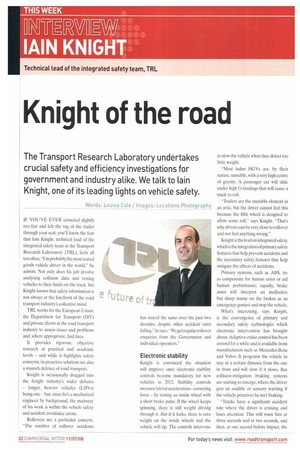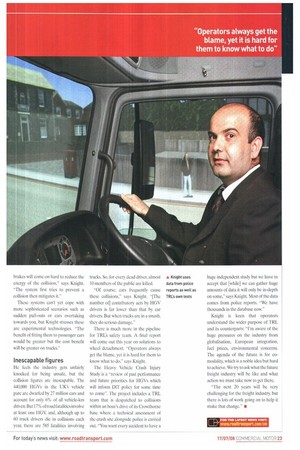Knight of the road
Page 22

Page 23

If you've noticed an error in this article please click here to report it so we can fix it.
The Transport Research Laboratory undertakes crucial safety and efficiency investigations for government and industry alike. We talk to lain Knight, oneof its leading tights on vehicle safety.
Words: Louise Cole Images: Locations Photography IF YOU'VE EVER cornered slightly too fast and felt the tug of the trailer through your seat, you'll know the fear that lain Knight, technical lead of the integrated safety team at the Transport Research Laboratory (TRL), feels all too often. "I'm probably the most seared goods vehicle driver in the world," he admits. Not only does his job involve analysing collision data and testing vehicles to their limits on the track. but Knight knows that safety information is not always at the forefront of the road transport industry's collective mind.
TRL works for the European Union. the Department for Transport (DfT) and private clients in the road transport industry to assess issues and problems and, where appropriate, find fixes.
It provides rigorous, objective research at practical and academic levels and while it highlights safety concerns, its proactive solutions are also a staunch defence of road transport.
Knight is occasionally dragged into the freight industry's wider debates longer, heavier vehicles (LHVs) being one but, since he's a mechanical engineer by background, the mainstay of his work is within the vehicle safety and accident avoidance arena.
Rollovers are a particular concern. "The number of rollover accidents has stayed the same over the past two decades, despite other accident rates falling," he says. "We get regularrollover enquiries from the Government and individual operators."
Electronic stability
Knight is convinced the situation will improve once electronic stability controls become mandatory for new vehicles in 2012. Stability controls measure lateral accelerationcornering force by testing an inside wheel with a short brake pulse. lithe wheel keeps spinning, there is still weight driving through it. But if it locks, there is zero weight on the inside wheels and the vehicle will tip. The controls intervene to slow the vehicle when they detect too little weight.
"Most laden HGVs are, by their nature, unstable, with a very high centre of gravity. A passenger car will slide under high G-loadings that will cause a truck to roll.
"Trailers are the unstable element in an attic, but the driver cannot feel this because the fifth wheel is designed to allow some roll," says Knight. -That's why drivers can be very close to rollover and not feel anything wrong."
Knight is the lead on integrated safety, which is the integration of primary safety features that help prevent accidents and the secondary safety features that help mitigate the effects of accidents.
Primary systems, such as ABS, try to compensate for human error or aid human performance; equally, brake assist will interpret an ineffective but sharp stamp on the brakes as an emergency gesture and stop the vehicle.
What's interesting, says Knight, is the convergence of primary and secondary safety technologies which electronic intervention has brought about. Adaptive cruise control has been around for a while and is available from manufacturers such as Mercedes-Benz and Volvo. It programs the vehicle to stay at a certain distance from the one in front and will slow if it slows. But collision-mitigation braking systems are starting to emerge, where the driver gets an audible or sensory warning if the vehicle perceives he isn't braking.
"Trucks have a significant accident rate where the driver is cruising and loses attention. This will warn him at three seconds and at two seconds, and then, at one second before impact, the brakes will come on hard to reduce the energy of the collision," says Knight. "The system first tries to prevent a collision then mitigates it."
These systems can't yet cope with more sophisticated scenarios such as sudden pull-outs or cars overtaking towards you, but Knight stresses these arc experimental technologies. "The benefit of fitting them to passenger cars would be greater but the cost benefit will be greater on trucks."
Inescapable figures He feels the industry gets unfairly knocked for being unsafe, but the collision figures are inescapable. The 440,000 HGVs in the UK's vehicle pare are dwarfed by 27 million cars and account for only 6% of all vehicle-km driven. But 17% of road fatalities involve at least one HGV, and, although up to 60 truck drivers die in collisions each year, there are 585 fatalities involving
trucks, So, for every dead driver, almost 10 members of the public are killed.
"Of course, cars frequently cause these collisions," says Knight. "[The number of] contributory acts by HGV drivers is far lower than that by car drivers. But when trucks are in a smash, they do serious damage."
"There is much more in the pipeline for TRL's safely team. A final report will come out this year on solutions to wheel detachment. "Operators always get the blame, yet it is hard for them to know what to do," says Knight.
The Heavy Vehicle Crash Injury Study is a "review of past performance and future priorities for HGVs which will inform MT policy for some time to come". The project includes a TRL team that is despatched to collisions within an hour's drive of its Crowthorne base where a technical assessment of the crash site alongside police is carried out. "You want every accident to have a huge independent study but we have to accept that [while] we can gather huge amounts of data it will only be in-depth on some," says Knight. Most of the data comes from police reports. "We have thousands in the database now."
Knight is keen that operators understand the wider purpose of TRL and its counterparts: "I'm aware of the huge pressures on the industry from globalisation, European integration, fuel prices, environmental concerns. The agenda of the future is for comodality, which is a noble idea but hard to achieve. We try to ask what the future freight industry will he like and what action we must take now to get there.
"The next 20 years will be very challenging for the freight industry, but there is lots of work going on to help it make that change." •
FOR THE LATEST NEWS VISIT: 7.kr www.roadtransport.convem












































































































































































